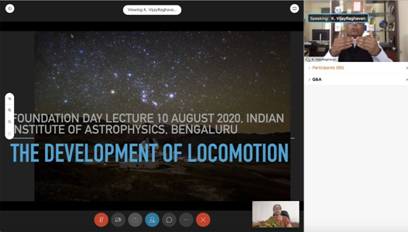Advances in microscopy has helped study complex questions of locomotion: Prof Vijay Raghavan
New Delhi: Professor K. VijayRaghavan, Principal Scientific Adviser to the Government of India, has highlighted how advances in microscopy has helped in the study of complex questions of walking and flying by allowing us to witness the cells at their finest resolution and revealing the specific components of the cells as well as their functions. He was delivering the Founder’s Day lecture of the Indian Institute of Astrophysics (IIA).
“Improvements in observational tools allow us to experiment, cells can be removed genetically, components of cells can be knocked down and their functions can be increased, and much can be derived from ‘loss of functions’ and ‘gain of functions’ technology, Professor K. VijayRaghavan said during his lecture on ‘The Development of Locomotion’ at the virtual celebration of the Founder’s Day on the 50 years of Indian Institute of Astrophysics, (IIA), an autonomous institute of the Department of Science & Technology, Govt. of India.
Referring to his experiments on the fruit-fly, he added that over the last twenty years, the tools of observation have been improved so much that one can open up the insect and observe what is happening. Further, various kinds of dyes and labels can be used to highlight various components, just like observational astronomy across various spectra.
Professor VijayRaghavan explained that locomotion or movement is the output of the nervous system reacting to the information we pick from our surroundings and depends on how we take it up and process it in our brain and spinal cord.
He elaborated that there is a substantial amount of work being done on the connectivity of the commands which control these movements. Another area of that has been focused on in the past 20 years is ‘how movement develops’ or ‘how a baby monkey runs around soon after its birth while humans cannot, as well as how the ability to move and deal with the real world is put together. “The answer to these questions lies substantially in breaking down the components required for movement in different units– the nervous system, muscles, tendons, connections to the brain and so on and asking how each of them develops just like in case of an automobile factory where different parts are manufactured to function perfectly and connect to other parts so that the interaction functions perfectly.
Professor VijyaRaghavan elucidated how two principal theories of biological sciences–Theory of evolution by natural selection and the concept of how chemistry on this planet is linked by the thread of the DNA, has helped understanding of one organism from the study of another. “The studies on the fruit fly have been of great importance in understanding various phenomenon like innate immunity because the same toolkit which is there in fruitfly is used to make a human being. What changes is the material and scale of implementation of rules, but the rules remains the same,” he pointed out.

